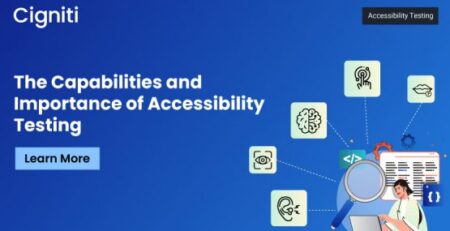From Compliance to Inclusivity: The Critical Need for Web Accessibility and Testing
In today’s digital age, the internet serves as a critical platform for information, communication, and commerce. The World Health Organization (WHO) estimates that 1.3 billion individuals, or 16% of the global population, have a major impairment. According to the Centers for Disease Control and Prevention (CDC), 27% of people, or approximately one in every four, have a handicap.
Suppose an organization’s website isn’t adhering to guidelines. In that case, the company could be missing out on revenues from these individuals (15% – 20% of your customer base) and is susceptible to lawsuits (most range from $5,000 to $25,000, but the largest corporations have incurred judgments in the millions!), not to mention the potential damage to brand perception and reputation.
Yet, millions of people with disabilities (both permanent and temporary) often encounter significant barriers when accessing web content. This underscores the urgent need for web accessibility conformance, which not only ensures inclusivity but also adheres to legal requirements, such as ADA compliance. This article explores the importance of web accessibility, its implications, and the various tools and strategies available for achieving accessibility compliance.
Understanding Web Accessibility and ADA Compliance
Web accessibility refers to the inclusive practice of making websites usable by people of all abilities and disabilities. We define this as designing and developing web content that can be easily navigated and understood by individuals who may have visual, auditory, motor, or cognitive impairments.
ADA website compliance stems from the Americans with Disabilities Act (ADA), a landmark civil rights law enacted in 1990. The ADA prohibits discrimination against individuals with disabilities in all areas of public life, including digital spaces. ADA web compliance mandates that businesses and organizations ensure their websites are accessible to all users, providing equal access and opportunity.
The Implications of Non-Compliance
In an audit of the top one million websites, WebAIM discovered that 95.9% had recognized WCAG compliance failures on their home pages, with an average of 56.8 problems per page. The most prevalent issue was low-contrast text, which affected 81% of home pages.
Given that most websites still fail to follow online content accessibility requirements, it’s no surprise that accessibility lawsuits have surged. In 2023, Accessibility.com recorded 2,281 online accessibility cases, 26% of which were brought against previously sued firms.
Failing to achieve web accessibility compliance can have severe repercussions for organizations and the public at large. Legally, organizations can face lawsuits and significant financial penalties for violating ADA regulations. Beyond the legal implications, we have noticed that non-compliance with these standards can damage an organization’s reputation, leading to a loss of trust and loyalty among consumers.
Moreover, inaccessible websites exclude a substantial portion of the population, potentially reducing the customer base, negatively impacting revenue, and limiting market reach. In contrast, utilizing end-to-end accessibility tools and embracing accessibility can enhance user experience, foster inclusivity, and ultimately drive business growth.
The Role of Accessibility Testing and Tools
Achieving web accessibility compliance involves rigorous accessibility testing, which evaluates whether a website meets established accessibility standards. Website accessibility testing identifies barriers that may prevent users with disabilities from fully engaging with web content. This process can be conducted using various accessibility testing tools, automated accessibility testing, manual testing, and usability testing services.
Automated Accessibility Testing
Automated accessibility testing employs software tools to scan websites for accessibility issues. These tools can quickly identify common barriers, such as missing alt text for images, improper heading structures, and common navigation issues impacting a consumer’s journey.
Automated tools offer the advantage of speed and efficiency, allowing organizations to detect and address accessibility issues early in the development process. It is estimated that scanning platforms typically identify 30% of the total possible guideline violations, leaving a manual effort to address the remaining 70%.
However, automated testing alone cannot capture all accessibility challenges, especially those related to user experience and interactive elements.
Manual Accessibility Testing
Manual testing complements automated methods by involving human testers who simulate the experiences of users with disabilities. This approach provides valuable insights into how well a website supports assistive technologies, such as screen readers and keyboard navigation. Manual testers can evaluate aspects like content readability, form usability, and overall user experience.
While more time-consuming, manual testing ensures a thorough assessment of accessibility compliance, addressing nuances that automated tools might overlook.
Usability Testing Services
Usability testing services specialize in evaluating the overall user experience of a website, including its accessibility and the specific user journeys associated with the site. These services involve real users with disabilities who test the website’s functionality and provide feedback on their experiences. This approach offers authentic insights into the challenges faced by users and helps organizations prioritize improvements. Usability testing services play a crucial role in creating websites that are not only accessible but also user-friendly and intuitive.
Web Accessibility Testing Tools
A variety of web accessibility testing tools are available to assist organizations in their journey toward accessibility compliance. Popular tools like Crownpeak’s DQM WAVE, Axe, and Lighthouse offer comprehensive assessments of web content, identifying both major and minor accessibility issues.
These tools provide detailed reports and recommendations for remediation, enabling developers and content editors to make necessary adjustments. Integrating web accessibility testing tools into the development lifecycle ensures continuous monitoring and improvement of accessibility standards. These tools also provide valuable evidence that a brand is addressing accessibility shortcomings by reporting on remediation progress.
Conclusion
Web accessibility is both a legal requirement and a moral imperative, fostering an inclusive digital environment. Prioritizing ADA compliance through accessibility testing tools and usability testing ensures that websites are accessible to all users. This approach mitigates legal risks, enhances user experience, and broadens audience reach.
Cigniti and Crownpeak offer a powerful combination of usability testing services and web accessibility testing tools. Crownpeak Digital Quality Management (DQM), a SaaS solution, helps manage digital policies, improve accessibility compliance, SEO, brand equity, and user experience by analyzing website content and code.
By leveraging their joint expertise, businesses can create inclusive and engaging online experiences, promoting digital equity and accessibility for everyone.
For more information, visit Cigniti Accessibility Testing.





Leave a Reply